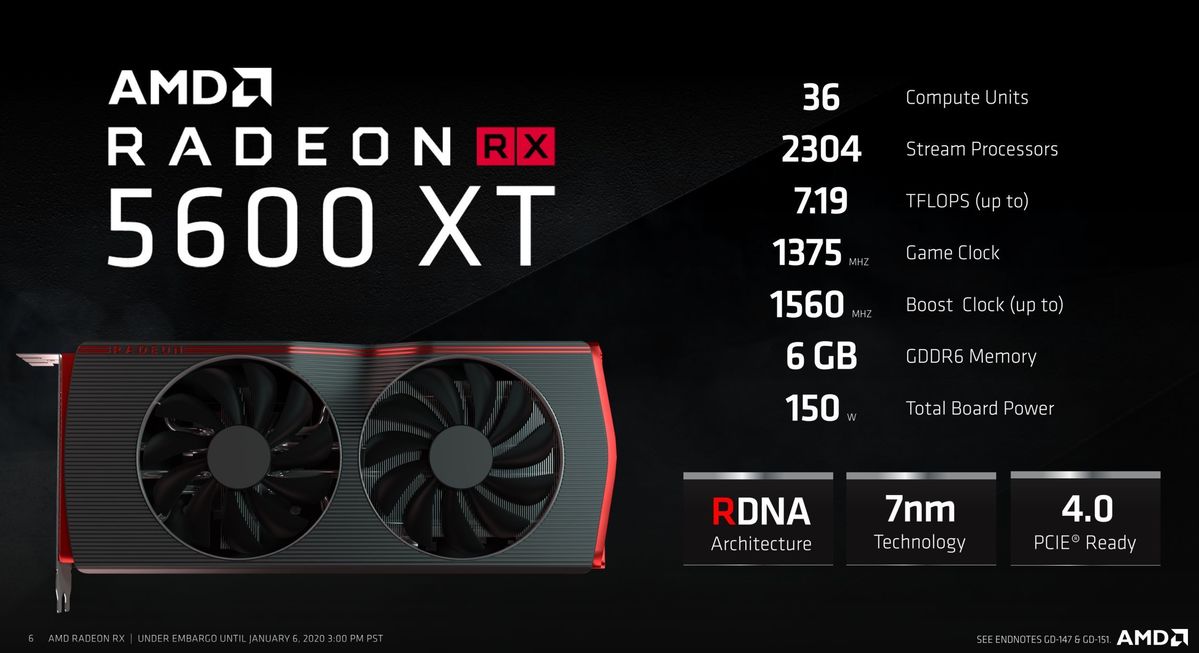With the launch of the $279 Radeon RX 5600 XT, AMD’s finishing off the mainstream push for its cutting-edge “Navi” architecture by aiming for PC gaming’s sweet spot, the no-compromises 1080p arena currently dominated by Nvidia’s trio of GeForce GTX 1660 graphics cards. It more than gets the job done—especially if you get the right overclocked model, equipped with a supercharged BIOS.
Yes, the Radeon RX 5600 XT can be much faster than AMD originally claimed, but you need to jump through some hoops to achieve those speeds if you’re an early buyer, adding a regrettable layer of confusion.
In the default configuration announced at CES 2020, the card does a solid job of matching up with Nvidia’s identically priced $279 GeForce GTX 1660 Ti. It’s good! But mere days before the card’s launch, AMD sent us a new BIOS for the custom $289 Sapphire Pulse Radeon RX 5600 XT on our test bench. This BIOS pushed the power limits to new levels, which allowed Sapphire to crank up the overclock on the GPU and the already blazing-fast GDDR6 memory.
Talk about an upgrade! With those unlocked capabilities, the Sapphire Pulse Radeon RX 5600 XT shifted from a solid GTX 1660 Ti alternative to a full-on rival for the $350 GeForce RTX 2060—and AMD’s own $350 Radeon RX 5700. AMD says select other models will receive the turbocharged BIOS as well.
“Jebaited,” round two, or a response to some GeForce RTX 2060 models dropping to $300 in the days ahead of the Radeon RX 5600 XT’s launch? Giddy-up either way.
AMD Radeon RX 5600 XT: Specs, features, price
Let’s kick things off by looking at the Radeon RX 5600 XT’s announced configuration, which remains AMD’s recommended reference design specs.
 AMD
AMDHere’s how we described the design in our original coverage:
“The Radeon RX 5600 XT is essentially a down-clocked version of the $350 Radeon RX 5700 with a reduced memory configuration. Its 36 compute units pack the same 2,304 stream processor count, but clocked much lower, at 1375 game and 1560 boost clocks. By comparison, the reference Radeon RX 5700 hit 1,625MHz game clocks (the typical clock speeds you can expect to see while gaming).
And while the pricier RX 5700-series kept their GPUs fed with 8GB of GDDR6 RAM over a 256-bit memory bus, the new Radeon RX 5600 XT sticks to 6GB of 12Mbps GDDR6 memory over a 192-bit bus. Don’t scoff, though: Moving to faster GDDR6 memory gives the Radeon RX 5600 XT an overall memory bandwidth of 288GBps, while the older Radeon RX 590’s GDDR5 RAM only hit 256GBps overall bandwidth despite using a wider 256-bit bus and a larger 8GB capacity.”
The Radeon RX 5600 XT will also support the modern features common to all “Navi” GPUs, such as PCIe 4.0 support, vastly increased power efficiency, and the latest display and media engines. AMD’s new card also supports all the fancy features enabled by Radeon Software Adrenalin 2020 Edition, such as Radeon Boost, Radeon Image…
https://www.pcworld.com/article/3514693/sapphire-pulse-amd-radeon-rx-5600-xt-review.html#tk.rss_all
